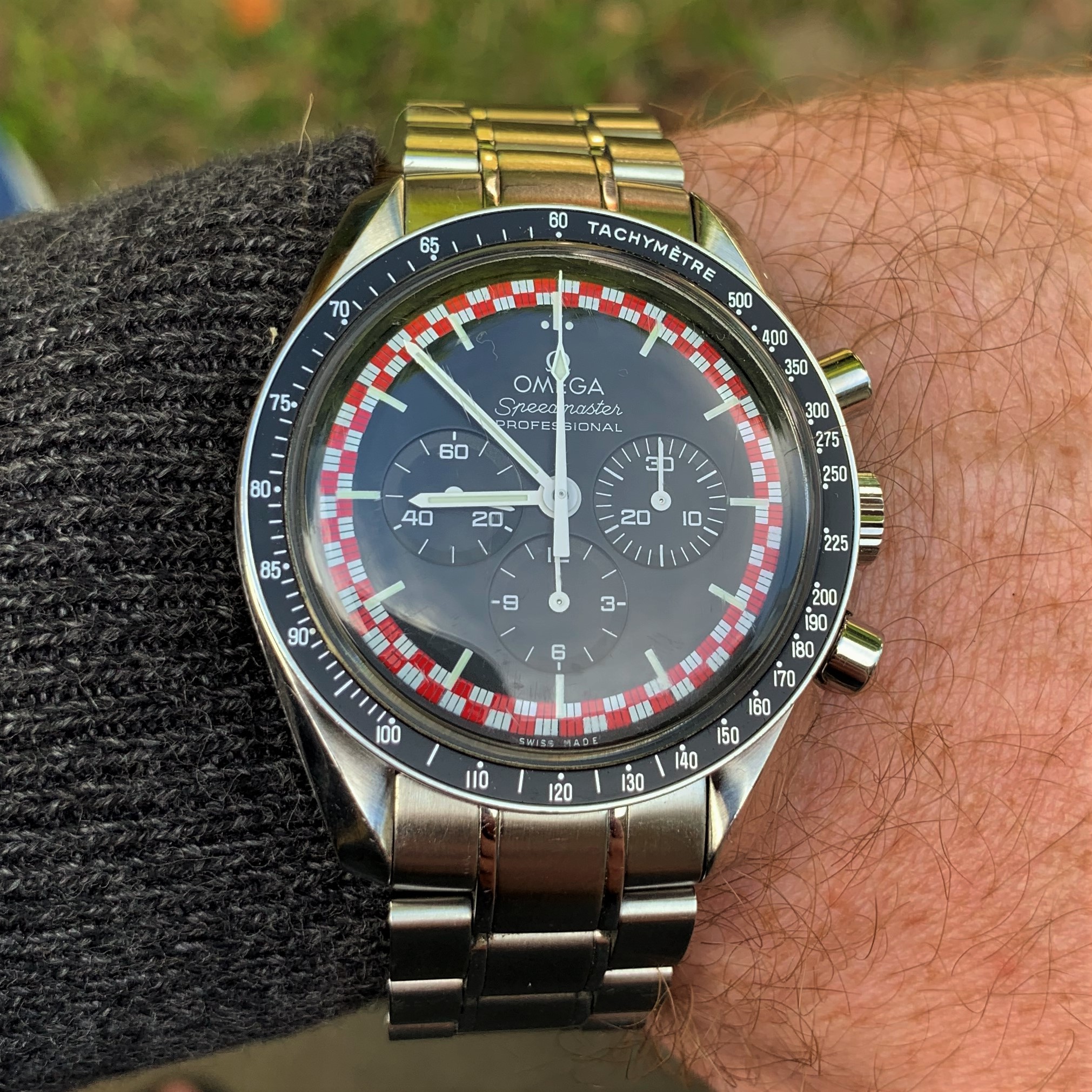For our second edition of My Spotlight, feature articles penned with our readers, we have joined with Mr S to explore his treasured Omega Speedmaster Tintin. Mr S has been a watch enthusiast for many years and has an eclectic collection of many pieces, with a particular affinity for this Speedmaster which he has had for 4 years. We met up with Mr S to learn about this piece and what it means to him whilst filming his first video for his Youtube channel, Ticker Talker.
A Brief History of the Omega Speedmaster
To start with, let’s take a look at the Omega Speedmaster. The word ‘iconic’ is often used to describe certain watches, such that the true meaning of the word is almost lost. However, when it comes to the Speedmaster, there aren’t many other words which will do it justice. The first Speedmaster references appeared in 1957, a racing chronograph timepiece in an era before digital timers where the chronograph was a tool used to measure time.
In 1964, NASA put out a request to 10 different brands they believed could meet their needs in the search for a reliable chronograph with which they could equip their astronauts. These 10 brands were Elgin, Benrus, Hamilton, Mido, Lucien Piccard, Gruen, Bulova, Rolex, Longines-Wittnauer and of course, Omega. Of these 10, only 4 submitted watches for testing: Longines-Wittnauer, Hamilton (who famously fell out of the race having proposed a pocket watch), Rolex and Omega. These tests were extreme in every sense of the word – they had to be to prove the watches could handle what could be in store for them, should they be chosen.
The testing included extremes of high and low temperature, tests within a temperature pressure chamber, humidity, shock, acceleration, high pressure and decompression, vibration, and prolonged loud noise. Essentially, everything you would never normally put a mechanical watch through!
The only watch to satisfactorily pass this testing was the Omega Speedmaster Professional.

Buzz Aldrin wearing his Omega Speedmaster, photo: NASA Buzz Aldrin photo gallery
In 1969, the Omega Speedmaster cemented its place in history and reached icon status when it became the first watch worn on the Moon, on the wrist of Buzz Aldrin (Neil Armstrong had left his on board the lunar module when he disembarked). It also played a significant and lifesaving role in the Apollo 13 emergency in 1970, when Jack Swigert used his Omega Speedmaster to count down a precise, 14 second burst of thrust required to alter the spacecraft’s trajectory to make it back to Earth safely.
This incredible feat of human endeavour is rightly lauded and celebrated by Omega, and over the years there have been a huge amount of Speedmaster references. I will be the first to admit I am far from knowledgeable in this area; there are some great resources available for further reading such as A Moon Watch Story: The Extraordinary Destiny of the Omega Speedmaster, Moonwatch Only: 60 Years of Omega Speedmaster (affiliate links), or the ‘Speedy Tuesday’ blog series by Speedmaster expert Robert-Jan Broer on Fratello Watches.
However, with this article we are going to focus on a discontinued edition of the Speedmaster belonging to Watch Affinity reader Mr S, to learn a little more about this piece in particular.
Omega Speedmaster Tintin
The model in question is the Omega Speedmaster Moonwatch Professional chronograph, reference 311.30.42.30.01.004 (you can learn more about Omega watch references and what these mean here). Or, as it is more commonly known by its nickname, the Speedmaster Tintin.

Omega Speedmaster 'Tintin', ref 311.30.42.30.01.004
This piece was first launched by Omega in 2013 at the Baselworld watch fair, although initially it was not particularly well received. Indeed, it was rather overshadowed by the other releases that year. Why was this? Well, for the most part this reference is a standard Speedmaster Moonwatch Professional – it is a standard 42mm case, standard Hesalite crystal as opposed to sapphire (this was used in the original Speedmaster Moonwatch as whilst Hesalite scratches easily, it does not shatter whereas sapphire crystal does – the last thing you want to happen in space), standard crown and pushers, a standard bracelet and standard clasp. The only differences are the red and white chequered pattern on the dial, and the caseback inscription being in red. These changes were not overly popular, and as a result the watch was not a great success, eventually being discontinued only a couple of years later.
It wasn’t until Speedmaster expert Robert-Jan Broer came to discuss this particular reference with a representative of Omega that the story behind its distinctive red and white chequered pattern came to light as not just being a racing dial. This story is of course from where its nickname emanates, and also plays a significant part in why Mr S sought to get a hold of one of these particular models.

As it transpired, the story behind the origins of this piece was that Omega were in negotiations with publishers Moulinsart to produce a Tintin Speedmaster with the rocket in the subdial at 9 o’clock, and a depiction on the caseback of Tintin and his terrier dog Snowy. However, Moulinsart pulled out of the project and the Tintin Speedmaster never materialised (except apparently for one example, kept under lock and key at Omega headquarters). And so, with the chequered dials already made, Omega released this model as a ‘racing’ Speedmaster.
This story, combined with the fact that the red and white chequered pattern used is very similar to the rocket depicted in the Tintin books Destination Moon and Explorers on the Moon (affiliate links), quickly earned the watch its affectionate nickname. Mr S told us “I grew up with Tintin. In those days, they weren’t easily available where I lived, but a friend’s father travelled regularly to Belgium for work, and eventually brought the entire series home for his sons. We found them endlessly fascinating and they resonated with our sense of adventure as boys. I own the entire series and to this day, I go back to the books regularly. Of course, when I became interested in watches and being a huge fan of both the Speedmaster and of everything Tintin, I became obsessed with this piece – it really was a must-have for me.”
Whilst the original plan may have been to depict a scene from Tintin on the caseback, as we have already touched upon, Omega instead opted to do something different with this reference. All Speedmaster Professional Moonwatch pieces have an inscription on the caseback reading “FLIGHT QUALIFIED BY NASA FOR ALL MANNED SPACE MISSIONS” and “THE FIRST WATCH WORN ON THE MOON”. With the Tintin, this inscription is done in red, and to date it remains the only Speedmaster to have this quirk.

Omega Speedmaster 'Tintin' caseback
As well as this, it is the only Speedmaster to have a red and white chequered pattern around the edge of the dial, believed to have been hand painted (or at least to have been reproduced from an original dial which was hand painted). Indeed, under a loupe Mr S showed us some of the imperfections which can be seen where the red colours bleed a little into the white. This certainly serves to add to the charm of this watch, setting it aside from a more manufactured, “perfect” pattern.
Another finer detail can be found on the tachymetre display around the bezel, which features what is known in Omega enthusiast circles as a ‘DNN’ – or dot-next-to-ninety – bezel. This is opposed to the earlier, prized after ‘DON’ – dot-over–ninety bezel, and refers to the placement of the small dot in relation to the 90 number the bezel; the DON bezel is found on Speedmasters from before 1970, whereas from 1970 onwards the placement of the dot was relocated to beside the 90.

Omega Speedmaster DNN (Dot Next to Ninety) Bezel
Inside, the watch contains the hand-wound mechanical chronograph movement, Calibre 1861 (a rhodium plated evolution of its predecessor, Calibre 861). Calibre 1861 affords the wearer up to 48 hours of power reserve when fully wound and has been in production since 1996. The fact that it has been in production for over 20 years, and predominantly used in the iconic Speedmaster is surely a nod to its reliability and precision.
As we mentioned earlier, this reference was discontinued after only 1 or 2 years, which meant that relatively few of the Speedmaster Tintin were ever made. “For me – and many collectors – part of the charm of the watch is that Omega has never said how many of the chequered dials exist,” Mr S explained. “For a long time, it was the hottest topic discussed in the Speedmaster forums, and some fans even tried to solve the mystery by asking for serial numbers from owners.”
Estimates of the total numbers range between 1000-2000. As a result, this number makes it both a rare watch and yet simultaneously not impossible to find on the second-hand market – or as Mr S succinctly put it “a bona fide limited edition that is not designated as such” – which makes it an increasingly attractive proposition for collectors with prices today of up to three times the original list price.
The rarity of the piece with its unique dial makes it somewhat notorious – even a Speedmaster novice such as myself is at least aware of the Tintin – as well as making it rather easy to spot from afar. As many watch enthusiasts will attest, conversations often start where an individual has noticed and recognised a timepiece from across the room, and Mr S told us how this particular watch has cultivated several conversations and even friendships, including a now close friend who lives on the other side of the world. This really is one of the most wonderful things I find about the world of watch enthusiasts.
I really enjoyed learning about this piece, and would like to extend a massive thank you to Mr S for taking the time to discuss his Speedmaster Tintin with Watch Affinity – hopefully you have enjoyed the article and learning about this great watch, too.
Don’t forget to subscribe to Mr S on Youtube – you can find his Ticker Talker channel here, and his video of the Speedmaster Tintin is below:
Ticker Talker - Omega Speedmaster Tintin
If you’re interested in getting involved with a My Spotlight guest article, please get in touch via our Contact page, or via our Instagram.
You might also be interested in:

